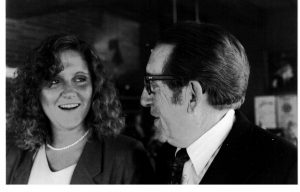One Man, One River
When great men or women die, the passage of time acts like rust working on iron: as years roll by, the societal remembrance of the departed slowly dissipates until there is only a vague recollection, a caricature of sorts, of the deceased left for consideration. Many of you have no idea who Willard Munger was or how his story is interwoven with that of the modern St. Louis River. Hopefully, this short essay will recall his fight to clean up and preserve the estuary that is the birthing place of the Great Lakes, the world’s largest repository of fresh water.
Willard was born on a farm in Otter Tail County, Minnesota on January 20, 1911, the son of an impoverished farmer and a homemaker of limited education. After a bout of illness, Munger graduated from Fergus Falls High School in 1932 and began working a series of jobs that eventually took him from northwestern Minnesota to Duluth. Other than a few marine drafting courses taken at UMD to secure a job in the shipyards of Duluth and Superior during WW II, Munger’s formal education ended with high school. However, despite this limited exposure to schooling, Willard Munger was steeped in the conservation ethic of his paternal grandfather, a man who, though a poor farmer, was a firm believer in the power of the political process to preserve the land and water for future generations. Lyman Munger exposed his grandson to the forests, marshes, rivers, and beauty of the natural world to be found in rural Otter Tail County, imprinting upon his young grandson a land ethic akin to that later immortalized by Wisconsin’s Aldo Leopold. Willard carried a vague and half-formed appreciation for the natural world with him when he arrived in the Twin Ports in 1935. Settling in Duluth, Munger’s imprecise and somewhat naive understanding of the environment and man’s ability to adversely “soil his own nest” collided with the reality of the tragedy occurring along the banks of the St. Louis River.
Willard Munger settled in northeastern Minnesota at the height of the Great Depression. His first reaction to the sewer laden, foul smelling, toxic waters of the great waterway dividing the industrial cities of Duluth and Superior was disgust. But, with a child on the way and a young wife at home, Munger reconciled the river’s ugliness with society’s need for economic progress and his own need to find work. It wasn’t until Reserve Mining proposed (in 1948) to obtain a permit from the State of Minnesota to dump waste from its taconite processing operation into the pristine waters of Lake Superior and Willard joined the United Northern Sportsmen of Duluth, that Willard came to realize the wrong headedness of what was happening to the St. Louis River and Lake Superior. It was then that the young liberal politician, steeped in the socialism of the Nonpartisan League and Farmer Labor Party of his grandfather and his parents, decided “enough is enough” and began to work against those in power who saw the St. Louis River as an open sewer and Lake Superior as an inexhaustible holding pond for industrial and municipal waste. Though the United Northern Sportsmen’s efforts to stop Reserve Mining’s plan to dump taconite tailings into the lake failed, that effort gave Munger confidence to run for public office. He’d run unsuccessfully, on an economic platform of reform rooted in his ancestor’s socialism, for the State Legislature in Otter Tail County as a twenty-one year old Farmer Laborite in 1934. He lost. He ran again for a position in the Minnesota House of Representatives in 1952 under the banner of the newly minted Democratic Farmer Labor Party, placing his passionate love for the St. Louis River estuary, and the need to regulate the waste being dumped into that delicate ecosystem, front and center in his campaign message. He lost again.
Rethinking his strategy, Munger came to realize that he was, in many ways, ahead of his time and his would-be constituents in the blue-collar neighborhoods of West Duluth that he proposed to represent. The environment, the cleaning up of the St. Louis River, was not high on the list of priorities for local voters. Jobs. Taxes. Preservation of social security and pensions. These were issues that galvanized Munger’s fellow West Duluthians, issues that Munger adopted as his own when he won a House seat in 1954. But the fact that Willard publically pivoted away from his dream of cleaning up the St. Louis River did not equate to an abandonment of principle. In 1955, as he took his seat in the Minnesota House of Representatives (a seat he held until his death in 1999) the very first piece of legislation Willard Munger sponsored was a bill seeking $25,000 to study the idea of treating industrial and municipal sewage through regional waste treatment districts. His request was promptly rejected by the conservative forces in control of the House. Undaunted, Munger brought the bill back during the next legislative session. Money was allocated in 1957 to study whether or not all of Minnesota’s rivers, not just Munger’s beloved St. Louis, were in need of rejuvenation. It took Willard Munger the next fifteen years to convince his brother and sister legislators that Minnesota’s shameful abuse of its rivers and streams needed corrective action.
Willard Munger’s foresight led to the creation of the Western Lake Superior Sanitary District, the WLSSD, a regional waste treatment facility that, along with a myriad of other conservation and environmental legislation Munger passed over a laudatory and lengthy political career, made Minnesota’s waterways cleaner. When Munger began his efforts to revitalize and reclaim the river, human feces floated in St. Louis Bay. The ancient fishery, one that boasted bountiful populations of walleye, pike, sturgeon, bass, and other game fish, was dead. The few walleye that managed to spawn in the turbid, toxic waters of the St. Louis were inedible. The sturgeon were gone, killed off by progress. The pike tended to stay out by the cooler, less polluted waters of the Big Lake. Today, on any given summer afternoon, one can look out across the flat, broad waters of the St. Louis River and see countless fishing boats bobbing at anchor or trolling the repatriated weed beds of a healthy ecosystem. Willard Munger’s persistence, his refusal to accept “no” for an answer, is a big reason why the folks in those boats are enjoying themselves.
As Willard’s staff assistant Ann Glumac once said, “I’ve known many famous, important men in my lifetime but I’ve only known one great man. That man was Willard Munger.” Indeed. Representative Munger’s life should not be forgotten but remembered by posterity as an example that even ordinary men can do extraordinary things.
Happy Earth Day 2016!
Mark
(This essay was originally written for the One River, Many Voices project regarding the history and importance of the St. Louis River. It was not chosen for airing on Wisconsin Public Radio but another of my essays, “Ducks”, was. Stay tuned!)

Ann Glumac and Rep. Munger



Hey, Mark!
What a lovely essay (and a fun picture). You may/may not know, but we now live two doors down from Willard’s house; I pass it at least twice a day while walking our dog and think of him every time. I think of him when I am kayaking or pontooning or just enjoying this amazing place. I know that my joy in experiencing this place is due to his foresightedness and, dare I say it, stubbornness?
I stand by my quote, and it’s more accurate as time goes on: Willard was the only great man I ever knew.
Ann
Ann: Patsy offered Willard’s house to me but it was too rich for my bank account! Plus, I don’t know as I could trade my river (the Cloquet) for the St. Louis. That would be a very tough choice. Watch my FB page and my blog for the air time of the essay I wrote that did make the cut in the One River Many Stories competition. It was recorded on Weds. in front of a live audience for WPR. You’ll recognize the landscape in that one as well!
Thanks.
Mark
Mark, my grandfather, Tony Sterle, was one of the founders of the United Northern Sportsmen’s Club. I followed in his shoes, working for DNR – Forestry in Cloquet for 32 years, before retiring in 2012. I’m now the MN Div. Past President of the Izaak Walton League, and a member of the W. J. McCabe Chapter in Duluth.
The Chapter is planning a 50th Anniversary Celebration of Earth Day, to be held at Lincoln Park Jr. High. In conjunction with American Heritage Productions, we will have a concert honoring some of the great voices for conservation, including Gaylord Nelson, Sig Olson, Rachel Carson, Aldo Leopold, John Muir, and of course “Mr. Environment” Willard Munger. As you may know Will and Sally are Chapter members.
I would feel very honored to have you attend. The concerts will be Sat., April 18th, with performances at 3:00 and 7:30. We are trying to assemble an Environmental Congress for students prior to the 3:00 show, so if you arrive early, you can take in their displays.
If you have any questions, need more information, just let me know. (218)384-4054
Hope to see you there. And if Ann is still in the area, please invite her as well.
P. S. I found this sight while looking for quotes of Willard. Hope to find something inspirational.
Could you send me an email to: cloquetriverpress@yahoo.com outlining the exact schedule so I can decide what I might be able to attend? Thanks for including me!